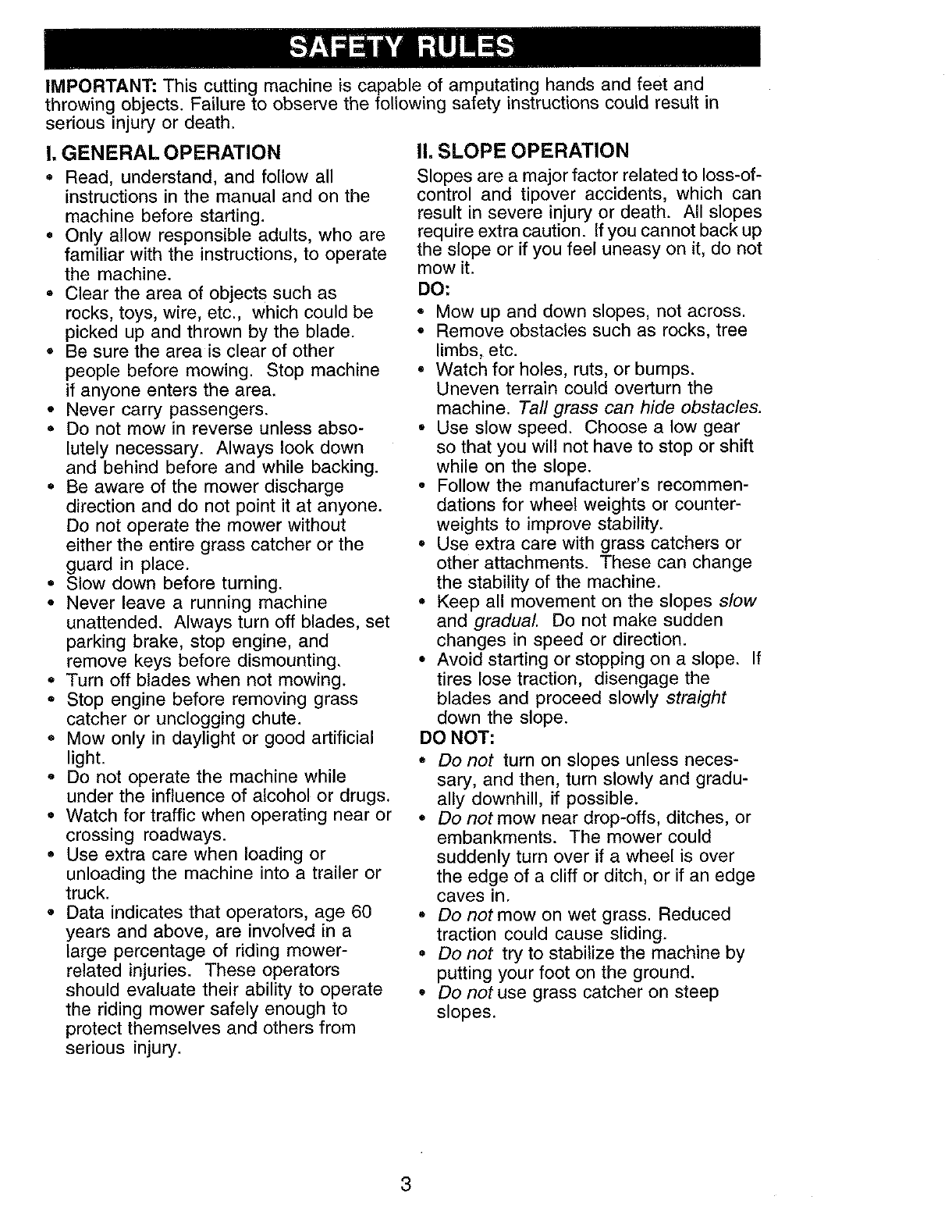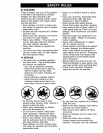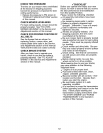
IMPORTANT:This cutting machine is capable of amputating hands and feet and
throwing objects. Failure to observe the following safety instructions could result in
serious injury or death.
I. GENERAL OPERATION
• Read, understand, and follow all
instructions in the manual and on the
machine before starting.
• Only allow responsible adults, who are
familiar with the instructions, to operate
the machine.
• Clear the area of objects such as
rocks, toys, wire, etc., which could be
picked up and thrown by the blade.
• Be sure the area is clear of other
people before mowing. Stop machine
if anyone enters the area.
• Never carry passengers.
. Do not mow in reverse unless abso-
lutely necessary. Always look down
and behind before and while backing.
° Be aware of the mower discharge
direction and do not point it at anyone.
Do not operate the mower without
either the entire grass catcher or the
guard in place.
° Slow down before turning.
o Never leave a running machine
unattended. Always turn off blades, set
parking brake, stop engine, and
remove keys before dismounting.
= Turn off blades when not mowing.
= Stop engine before removing grass
catcher or unclogging chute.
. Mow only in daylight or good artificial
light.
o Do not operate the machine while
under the influence of alcohol or drugs.
° Watch for traffic when operating near or
crossing roadways.
• Use extra care when loading or
unloading the machine into a trailer or
truck.
° Data indicates that operators, age 60
years and above, are involved in a
large percentage of riding mower-
related injuries. These operators
should evaluate their ability to operate
the riding mower safely enough to
protect themselves and others from
serious injury.
I1.SLOPE OPERATION
Slopes are a major factor related to loss-of-
control and tipover accidents, which can
result in severe injury or death. All slopes
require extra caution. If you cannot back up
the slope or if you feel uneasy on it, do not
mow it.
DO:
* Mow up and down slopes, not across.
° Remove obstacles such as rocks, tree
limbs, etc.
, Watch for holes, ruts, or bumps.
Uneven terrain could overturn the
machine. Tall grass can hide obstacles.
. Use slow speed. Choose a low gear
so that you will not have to stop or shift
while on the slope.
o Follow the manufacturer's recommen-
dations for wheel weights or counter-
weights to improve stability.
. Use extra care with grass catchers or
other attachments. These can change
the stability of the machine.
° Keep all movement on the slopes slow
and gradual Do not make sudden
changes in speed or direction.
° Avoid starting or stopping on a slope. If
tires lose traction, disengage the
blades and proceed slowly straight
down the slope.
DO NOT:
, Do not turn on slopes unless neces-
sary, and then, turn slowly and gradu-
ally downhill, if possible.
. Do not mow near drop-offs, ditches, or
embankments. The mower could
suddenly turn over if a wheel is over
the edge of a cliff or ditch, or if an edge
caves in.
° Do not mow on wet grass. Reduced
traction could cause sliding.
o Do not try to stabilize the machine by
putting your foot on the ground.
. Do not use grass catcher on steep
slopes.
3


















